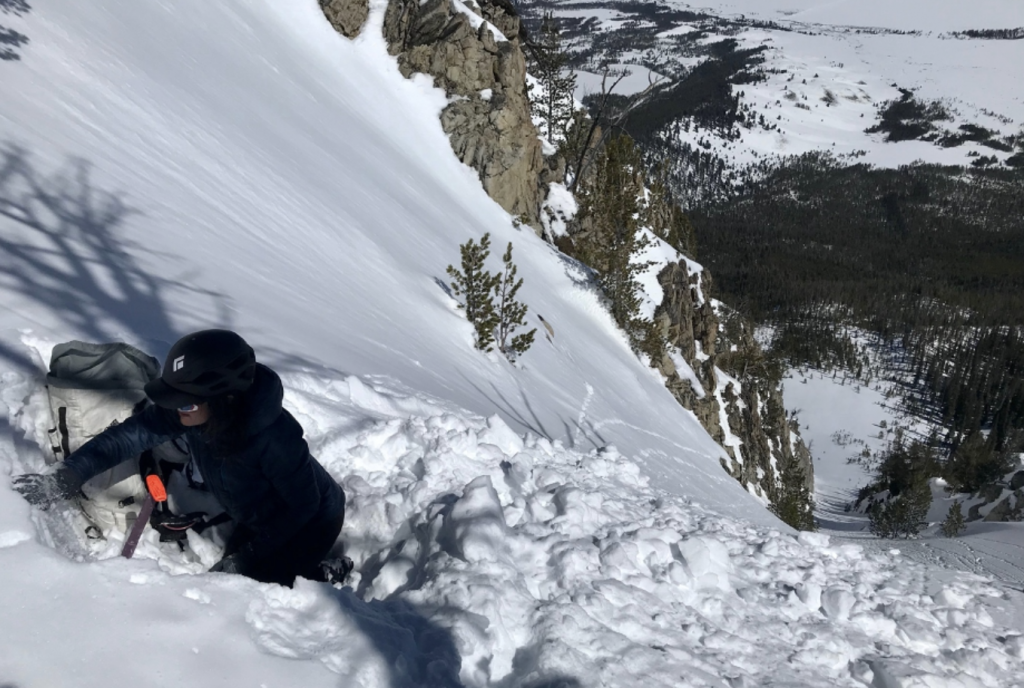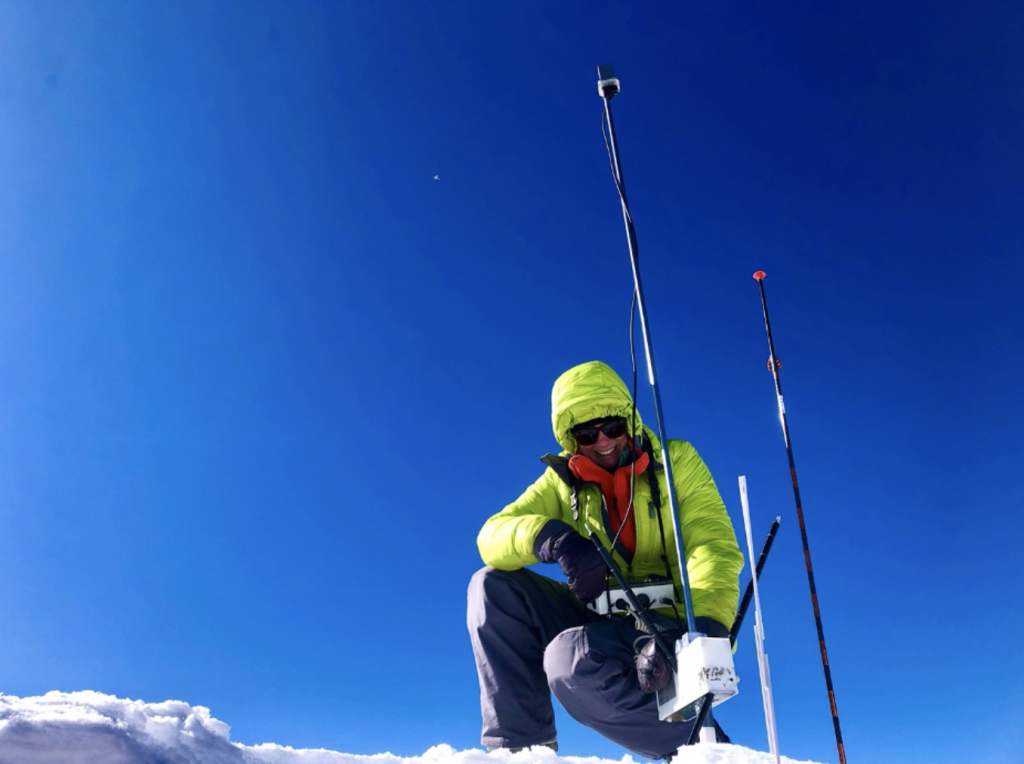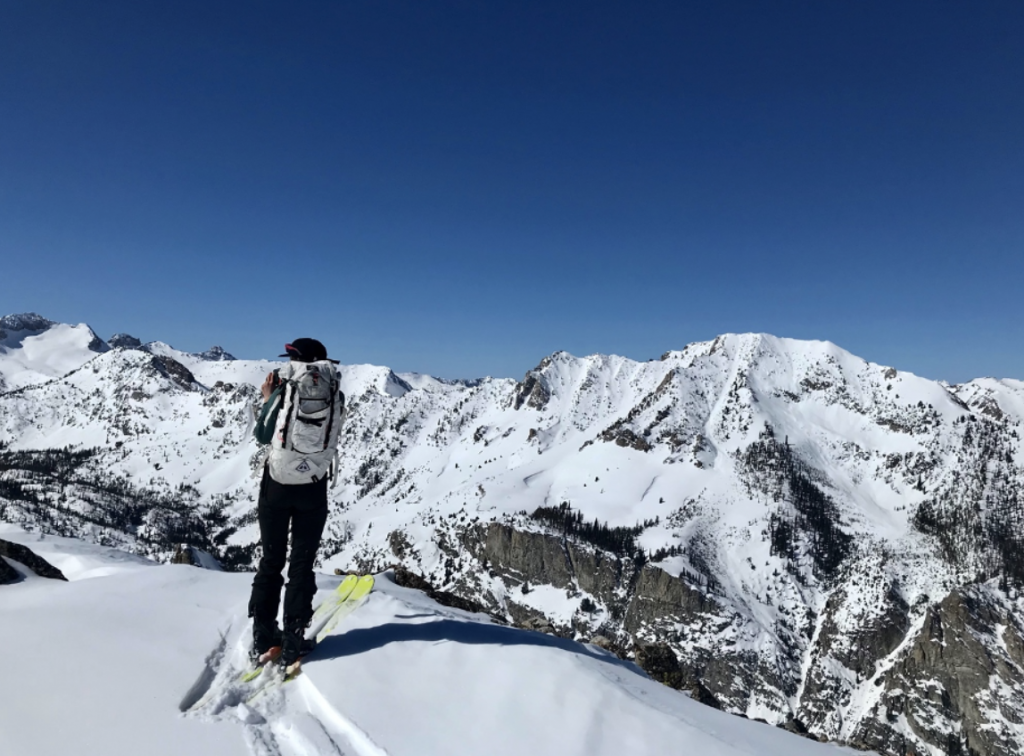By Gabrielle Antonioli, Montana State University /BOISE, IDAHO/
“Watch me,” I say to Megan as I tip my skis over the edge of snow at the top of a steep gully in the southern portion of the Sawtooth Mountains in Idaho. She nods knowingly from the ridge above. Not letting her eyes leave me, she watches as I quickly pop off my skis and get my shovel out of my backpack to dig a snow pit. Though this pit is smaller than the snow pit we dug the previous day at the Banner Summit weather station and radar site, it gives us a similar glimpse at the structure of the layered snow under our feet. After a quick test to assess the strength and stability of the snowpack as well as look at the overall structure of the top meter of snow, I determine the snow looks stable (which means the risk of avalanche is low) and we start our ski descent down the narrow snow gully.

The intersection between scientists who study snow and those who are fascinated with mountaineering and avalanches is an interesting one, to say the least. Like many other Earth sciences, we must venture out into the element of study and observe it carefully and with a curious mind to start to understand the complex dynamics by which it operates. And though the snow-centric field of cryosphere science is infinitely interesting, it is an intimidating path to choose. Women in cryosphere sciences – whether on the path of data scientist, glacier researcher, or avalanche forecaster – are few and far between. I met like-minded women like Megan Mason and Isis Brangers when I joined HP Marshall’s Cryosphere Geophysics and Remote Sensing group (CryoGARS) at Boise State University and the NASA SnowEx 2020-2021 campaign he led as co-project scientist. Isis is currently finishing her Ph. D. with the CryoGARS group and previously worked on a project studying snow depth over the European Alps with the European Space Agency’s Sentinel-1 satellite. Megan is currently a research scientist for NASA’s Goddard Space Flight Center.

SnowEx campaigns utilize traditional snowpit observation techniques alongside techniques aimed at being able to monitor and infer properties about the snow from afar. These include Unmanned Aerial Vehicles (UAVs), light detection and ranging (LiDAR), SnowMicroPenetrometry (SMP), liquid water content sensors, ground-penetrating radar, and airborne inferometric synthetic aperture radar (InSAR).

Remote detection of snow water equivalent (SWE) – or how much liquid water a snowpack contains – has long been a goal of hydrologic scientists. SWE is important to other branches of the snow world, like avalanche control and forecasting, which attracts a variety of scientists with specialized skill sets that enable them to reach mountain locations in winter. This work is challenging and involves risk, and I’m continually inspired by the women I meet that can troubleshoot a faulty weather station, dig a full profile science snow pit in a blizzard, and handle adversity of any kind with positivity and determination.

Large hydrology-focused projects like SnowEx can directly benefit the snow and avalanche community, and subsequently many economies across the mountain west. This is where the intersection between backcountry skier and snow scientist occurs. Mapping SWE throughout a mountain range in real-time would shift the entire landscape of forecasting for both snow hazard and spring water run-off monitoring. Currently, these monitoring efforts are based on using index sites such as Snowpack Telemetry sites, or SNOTELs, combined with historical knowledge and experience, to help extrapolate how much water the snowpack holds. Even with current technology, precipitation estimates are relatively unreliable in some places and can be highly uncertain in both amount and type of precipitation. With remote sensing technologies like those being tested with SnowEx, and the women behind the scenes working to improve these technologies, we can fill that gap.

The focus of the 2021 SnowEx airborne and field effort in Idaho was part of an experiment at sites in the Boise and Sawtooth mountains, in addition to sites in Utah, Colorado, and Montana. Radar sensors were flown at 40,000 feet each week across all sites from January through March, producing a time series. The sensor that was used has shown promise for mapping changes in SWE and a similar sensor may one day be launched into space in 2023 by a joint NASA and Indian Space Research Organization satellite mission called NISAR.
Though the 2022 SnowEx campaign was canceled due to COVID-19 concerns, data collection continued at ground-based radar station sites and helicopter LiDAR flyovers continued over these zones. This data is key to refining remote sensing technologies for snow. Collecting data that is both accurate over large areas and sampled at frequent time points is important because accurate snow data estimations require that our instruments are precise.
Snow research is a challenging field to enter, but barriers to that entry are getting lower. Women like Isis and Megan forge a path for others to enter the field with less resistance and support to reach even further. Snow’s ability to serve as a water reservoir is shifting beneath our feet due to climate change, whether we sense it or not. Disparities in weather patterns, rising rain lines in the mountains, and unpredictable climate patterns are at our doorstep. Research like the NASA SnowEx campaign is key in developing new tools to observe these environmental changes. Our efforts to synthesize and utilize new and non-traditional tools as well as offer a diverse and supportive workplace can help us better understand the past and the changing future.



